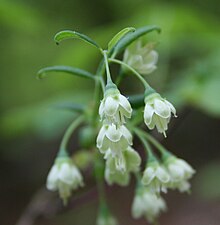Squaw huckleberry
| Vaccinium stamineum | |
|---|---|
 |
|
| Scientific classification | |
| Kingdom: | Plantae |
| (unranked): | Angiosperms |
| (unranked): | Eudicots |
| (unranked): | Asterids |
| Order: | Ericales |
| Family: | Ericaceae |
| Genus: | Vaccinium |
| Species: | V. stamineum |
| Binomial name | |
|
Vaccinium stamineum L. 1753 |
|
| Synonyms | |
|
Synonymy
|
|
Vaccinium stamineum, commonly known as deerberry, tall deerberry, squaw huckleberry, highbush huckleberry, buckberry, and southern gooseberry, is a species of flowering plant in the heath family. It is native to North America, including Ontario, the eastern and central United States, and parts of Mexico. It is most common in the southeastern United States.
This species is quite variable in morphology. It is a shrub usually growing up to 1.5 meters (60 inches or 5 feet) tall, but reaching up to 3 meters (10 feet) at times. It has multiple twisted trunks covered in peeling reddish bark and is highly branched, tapering into thin twigs, some just a millimeter wide. It is deciduous, with alternately arranged leaves. The thin leaf blades are yellow-green, sometimes hairy or waxy in texture, especially on the undersides, and oval in shape with pointed tips and smooth edges. They are up to 7 centimeters (2.8 inches) long by 2.5 cm (1 inch) wide. The flowers are borne in hanging inflorescences from the leaf axils. Each flower has five green sepals and a bell-shaped corolla of five fused white petals about half a centimeter (0.2 inches) long. The long, yellow stamens protrude, bearing long, tubular anthers. The style is longer than the stamens. The fruit is a spherical berry about a centimeter wide. It is greenish or yellowish, often with a purple tinge.
This plant usually grows in dry, rocky habitat types in forests and fields, but it sometimes occurs in moist areas such as bogs and swamps. It grows in acidic, well-drained soils. It is wildfire-adapted and associated with fire-tolerant vegetation.
It establishes via seed, and commonly spreads via woody rhizomes, with a single plant forming what appears to be a thicket with many trunks. Because most of the mass of the plant is underground, it easily survives fire and the above-ground parts grow back.
...
Wikipedia

